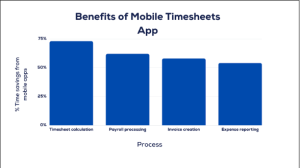In the fast-paced business world, every minute counts. Tracking employee time and getting accurate records is crucial for payroll, billing, and more. While traditional paper timesheets served their purpose, businesses today need agile solutions to keep up. This is where mobile timesheet apps come in – offering convenience, accuracy, and significant automation.
Let’s explore how these apps are revolutionizing time tracking
The Evolution of Mobile Time Tracking
As mobile devices became ubiquitous, it made sense to leverage them for streamlining time tracking. Apps allow employees to clock in or out and track time right from their smartphones – anytime, anywhere.
The key benefits driving this evolution are:
- Convenience– Employees can start tracking time as soon as they begin work, without having to rush to the office. Location services confirm attendance.
- Accuracy– Automated time tracking removes human errors in manual calculations and data entry.
- Real-time visibility– Managers can view timesheets and run reports from anywhere, on any device.
- Lower costs–Apps eliminate the need for expensive hardware, such as physical punch clocks.
Following is the line chart that explains the popularity of the timesheet apps in the business world from 2013-2018. (Data from Statista)

Key Features of Mobile Timesheet Apps
Let’s look at some of the most useful features that set modern mobile timesheet apps apart:
- Clock in/out– Employees can easily clock in and out or pause and resume timers with one tap. The app utilizes GPS and geofencing to confirm that they are at the expected location when clocking in.
- Offline access– Even without internet access, employees can clock time which automatically syncs when they are back online. This allows uninterrupted time tracking.
- Team time tracking– Managers can view timesheets and clock in entire teams or crews with one click. This simplifies managing field staff across multiple sites.
- Project tracking– All time entries are linked to specific projects and tasks for accurate billing and cost analysis. Managers can track project costs vs estimates in real time.
- Overtime alerts– Customizable alerts notify managers when employees approach overtime thresholds for timely intervention.
- PTO requests– Employees can submit PTO requests which managers can instantly approve or deny from their devices. Syncs with the company calendar.
- Receipt capture– Any receipt can be photographed and attached to a timesheet or expense report for reimbursements and billing.
- Digital signatures– To approve timesheets, invoices, or sign-off on projects, authorized personnel can add legally-binding e-signatures directly on the app.
- Reminders and alerts – The app sends reminders for timesheet approval deadlines, mistakes to correct, missing punches, upcoming shifts or events.
- Custom fields– Businesses can add fields like job codes, cost center numbers, mileage tracked, etc. specific to their needs.
- Real-time reports– Managers can access reports on employee hours, project costs, overtime, PTO balances, etc. on demand.
This diverse feature set optimizes time tracking for today’s agile, distributed workforce.
The Advantages of Using Mobile Timesheet Apps
It’s clear that mobile timesheet apps provide rich functionality. But how exactly do businesses benefit from using them?
1. Accuracy
With automated time tracking, human errors are eliminated in attendance and time calculations. Features like geo-fencing ensure employees clock in and out from required locations. Data flows seamlessly to payroll systems without manual re-entry.
2. Real-Time Visibility
Manager dashboards provide real-time visibility into team timesheets, schedules, PTO, and project costs versus estimates. Issues can be identified and addressed promptly before they escalate.
3. Lower Costs
Mobile apps significantly reduce hardware, installation, maintenance, and training costs compared to traditional punch clocks and biometrics systems. There are also cost savings from eliminating paper timesheets.
4. Compliance
Advanced apps provide comprehensive audit trails and data exports needed for payroll, client billing, and regulatory compliance.
5. Employee Convenience
Employees can clock in, switch projects, enter expenses, request PTO, and view schedules directly from their phones, from anywhere.
Following is the bar chart that displays the amount of time saved by implementing the timesheet app.

Addressing Common Concerns
While mobile apps provide undisputed advantages, some common concerns are:
Data Privacy and Security
Reputable apps use encryption, access controls, multi-factor authentication, and stringent security measures to safeguard company and employee data. ISO 27001 certification, SOC 2 Type 2 attestations, and regular audits validate these security practices.
Storage and Accessibility
Cloud-based systems remove worries about hardware failures or lost timesheets. Data storage needs are minimal – a few MBs per user monthly. Access permissions ensure that only authorized individuals can view assigned timesheets and reports.
Oversight for Managers
Manager dashboards provide real-time visibility and tools needed to properly oversee projects and gather approvals. Alerts flag potential issues like missed clock-ins, unauthorized overtime etc. for timely intervention.
Making the Switch: Implementation and Training
Transitioning to a mobile timesheet system may seem daunting initially. Proper planning, training, and change management will ensure a smooth rollout.
Key Steps for Implementation
- Evaluate business requirements: Assess which features are relevant for your workflows – scheduling, overtime policies, expenses, etc. Shortlist vendors accordingly.
- Validate security protocols: Review the vendor’s data security, access controls, compliance audits, etc. to verify they meet your standards.
- Set up key users: Create accounts for admins, managers, and employee test groups. Configure settings like bill rates, pay rules, PTO policies, etc.
- Pilot test: Run a limited pilot to iron out issues before a full rollout. Gather feedback to improve training.
- Train employees: Schedule virtual or on-site training sessions. Ensure employees understand timesheet workflows – when to clock in/out, how to enter expenses, approve schedules, etc.
- Roll out company-wide: With tested processes and training complete, roll out the app across the organization. Monitor adoption metrics and fine-tune them as needed.
Best Practices for Smooth Adoption
- Make training mandatory for all new hires
- Send regular app usage reminders and quick tip emails
- Incentivize teams and individuals for consistent app adoption
- Address concerns transparently and quickly
- Solicit user feedback frequently for enhancements
- Gamify adoption by showing leaderboards for utilization, accuracy etc. Enable peer feedback to motivate employees.
- Share success stories and measurable results from app adoption like time savings, reduced late timesheets etc.
- Pair new users with app ambassadors to provide ongoing guidance and support beyond just training.
- Analyze usage data frequently. Follow up with inactive users individually to address barriers faced.
- Reward teams and employees showing consistent adoption. Highlight them as role models.
When researching vendors, look for apps that provide deep integration capabilities out-of-the-box, eliminating the need for costly custom development. For instance, Homebase’s timesheet app seamlessly syncs payroll, schedules, and other data between its time tracking platform and 150+ business tools like Quickbooks, Xero, Gusto, and more.
Case Study: QuickBooks Time Mobile App
QuickBooks Time is an intuitive timesheet app that exemplifies the key benefits of mobile time tracking.
Key features like GPS-based clock in/out, overtime alerts, and project costing help Solscape Landscaping improve accuracy and real-time visibility. Office manager Denise Jackson says,
“We have crews spread across different sites each day. With QuickBooks Time, I can see where everyone is clocked in and ensure no one is missing any hours.”
Thanks to seamless QuickBooks integration, time and billing are fast and error-free. Denise Jackson, the office manager, explains, ‘We bill clients weekly, and our accountant uses Time data for payroll. Transferring data manually used to take hours but now it’s done in minutes,” says Jackson.
Crew leads use the app daily to clock in 12-15 field staff from one device. Jackson says,
“Thanks to Time, we reduced time theft and gained back 3-4 hours a week in lost productivity per crew. Plus, the app paid for itself within 2 months just from those time savings alone.”
FAQs
- How much storage space does a typical mobile timesheet app require?
Most mobile timesheet apps use very minimal storage on devices – usually a few MBs per user monthly. Data is stored in the cloud, not on the device itself. Internet access is needed to sync timesheets initially but offline mode allows clocking time anytime.
- How do mobile timesheet apps ensure user privacy and data protection?
Reputable apps use enterprise-grade security measures like data encryption, access controls, stringent app permissions and regular security audits. Employee location data, timesheets and personally identifiable information are protected as per regulations like GDPR and CCPA.
- How can managers effectively oversee projects and gather timesheet approvals using the app?
Manager dashboards provide real-time visibility into team timesheets, schedules, project costs vs estimates and other KPIs needed for oversight. Features like overtime alerts, geofencing ensure policies are followed. Digital approvals, alerts and detailed audit trails improve compliance and accountability.
Final Thoughts
A mobile timesheet app checks all the boxes for an agile, modern time-tracking system. Convenience, accuracy, and real-time visibility together make managing a dynamic workforce effortless. While initial user adoption requires planning, the long-term benefits far outweigh the effort. The time and cost savings quickly add up, making mobile time tracking a win-win for managers and employees alike.



